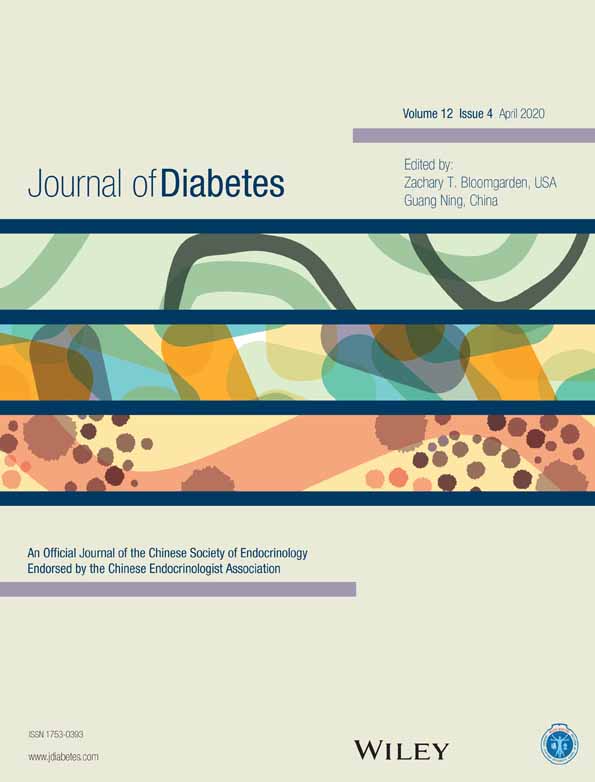Dietary preferences and diabetic risk in China: A large-scale nationwide Internet data-based study
中国的饮食偏好和糖尿病风险研究:一项基于大规模互联网数据的全国性研究
Funding information: Ministry of Science and Technology of the People's Republic of China, Grant/Award Numbers: 2016YFC0901200, 2016YFC1304904, 2016YFC1305600, 2017YFC1310700, 2018YFC1311800; National Natural Science Foundation of China, Grant/Award Numbers: 81500610, 81500660, 81621061, 81622011; Shanghai Municipal Commission of Health and Family Planning, Grant/Award Number: 20174Y0014; the Program for Professor of Special Appointment (Younger Eastern Scholar) at Shanghai Institutions of Higher Learning, Grant/Award Number: QD2016007
Abstract
enBackground
Unhealthy diet is one of the important risk factors of diabetes, which is one of the major public health problems in China. The Internet tools provide large-scale passively collected data that show people's dietary preferences and their relationship with diabetes risk.
Methods
212 341 708 individuals' dietary preference labels were created based on Internet data from online search and shopping software. Metabolic data obtained from the 2010 China Noncommunicable Disease Surveillance, which had 98 658 participants, was used to estimate the relation between dietary preferences geographical distribution and diabetes risk.
Results
Chinese dietary preferences had different geographical distribution, which is related to the local climate and consumption level. Fried food preference proportion distribution was significantly positively correlated with diabetes prevalence, hypertension prevalence and body mass index (BMI). Similarly, grilled food preference proportion distribution had significantly positive correlation with the prevalence of diabetes and hypertension. In contrast, spicy food preference proportion distribution was negatively correlated with diabetes prevalence. Sweet food preference proportion distribution was positively related to diabetes prevalence. Using dietary preferences data to predict regional prevalence of diabetes, hypertension and BMI, the average values of error (95% CI) between the three paired predicted and observed values were 9.8% (6.9%-12.7%), 7.5% (5.0%-10.0%) and 1.6% (1.2%-2.0%), respectively.
Conclusions
Fried food, grilled food, and sweet food preferences were positively related to diabetes risk whereas spicy food preference was negatively correlated with diabetes risk. Dietary preferences based on passively collected Internet data could be used to predict regional prevalence of diabetes, hypertension, and BMI and showed good value for public health monitoring.
摘要
zh背景
糖尿病是中国面临的主要
公共卫生问题之一, 而不健康饮食是糖尿病的一个重要的危险因素。互联网工具提供了大规模的被动采集的数据, 这些数据显示了人们的饮食偏好及其与糖尿病风险的关系。
方法
根据来自搜索引擎和外卖购物软件的互联网数据, 创建了212, 341,708人的饮食偏好标签。代谢状态数据来自于2010年中国慢病监测项目(共有98,658名参与者), 并用于估计饮食偏好的地理分布与糖尿病风险之间的关系。
结果
中国人的饮食偏好具有不同的地理分布, 其分布与当地的气候和消费水平有关。油炸食品偏好的比例分布与糖尿病患病率, 高血压患病率和体重指数呈显着正相关。同样, 烧烤食物偏好的比例分布与糖尿病、高血压的患病率也呈显着正相关。相反, 辛辣食物偏好的比例分布与糖尿病患病率呈负相关。甜食偏爱的比例分布与糖尿病患病率呈正相关。使用饮食偏好数据来预测区域的糖尿病、高血压的患病率及体重指数, 三组预测值和观察值之间的平均误差(95%可信区间)分别为9.8%(6.9%-12.7%), 7.5%(5.0%- 10.0%)和1.6%(1.2%-2.0%)。
结论
油炸食物, 烧烤食物和甜食的偏好与糖尿病风险呈正相关, 而辛辣食物的偏好与糖尿病风险呈负相关。基于被动采集的互联网数据的饮食偏好可用于预测糖尿病, 高血压和体重指数的区域患病率, 并在公共卫生监测中显示出良好的价值。
CONFLICT OF INTEREST
No potential conflicts of interest relevant to this article are reported.




